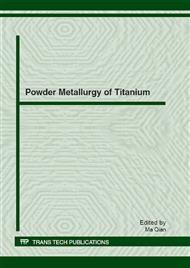[1]
M. Balazic, J. Kopac, M.J. Jackson, W. Ahmed, Review: titanium and titanium alloy applications in medicine, Int. J. Nano and Biomaterials 1 (2007) 3-34.
DOI: 10.1504/ijnbm.2007.016517
Google Scholar
[2]
M. Geetha, A.K. Singh, R. Asokamani, A.K. Gogia, Ti based biomaterials, the ultimate choice for orthopaedic implants–A review, Prog. Mater. Sci. 54 (2009) 397-425.
DOI: 10.1016/j.pmatsci.2008.06.004
Google Scholar
[3]
Y.L. Zhou, D.M. Luo, Corrosion behavior of Ti–Mo alloys cold rolled and heat treated, J. Alloys Compd. 509 (2011) 6267-6272.
DOI: 10.1016/j.jallcom.2011.03.045
Google Scholar
[4]
M.M. Dewidar, K.A. Khalil, J.K. Lim, Processing and mechanical properties of porous 316L stainless steel for biomedical applications, Trans. Nonferrous Met. Soc. China 17 (2007) 468-473.
DOI: 10.1016/s1003-6326(07)60117-4
Google Scholar
[5]
H.I. Bakan, A novel water leaching and sintering process for manufacturing highly porous stainless steel, Scripta Mater. 55 (2006) 203-206.
DOI: 10.1016/j.scriptamat.2006.03.039
Google Scholar
[6]
I.H. Oh, N. Nomura, N. Masahashi, S. Hanada, Mechanical properties of porous titanium compacts prepared by powder sintering, Scripta Mater. 49 (2003) 1197-1202.
DOI: 10.1016/j.scriptamat.2003.08.018
Google Scholar
[7]
Z. Esen, S. Bor, Characterization of Ti-6Al-4V alloy foams synthesized by space holder technique, Mater. Sci. Eng., A 528 (2011) 3200-3209.
DOI: 10.1016/j.msea.2011.01.008
Google Scholar
[8]
C.L. Chu, C.Y. Chung, P. H. Lin, S.D. Wang, Fabrication of porous NiTi shape memory alloy for hard tissue implants by combustion synthesis, Mater. Sci. Eng., A 366 (2004) 114-119.
DOI: 10.1016/j.msea.2003.08.118
Google Scholar
[9]
Y.H. Li, L. J. Rong, Y. Y. Li, Pore characteristics of porous NiTi alloy fabricated by combustion synthesis, J. Alloys Compd. 325 (2001) 259-262.
DOI: 10.1016/s0925-8388(01)01382-2
Google Scholar
[10]
D.Y. Yang, H.P. Shao, Z.M. Guo, T. Lin, L.P. Fan, Preparation and properties of biomedical porous titanium alloys by gelcasting, Biomed. Mater. 6 (2011) 1-8.
DOI: 10.1088/1748-6041/6/4/045010
Google Scholar
[11]
Y. Li, Z.M. Guo, J.J. Hao, S.B. Ren, Porosity and mechanical properties of porous titanium fabricated by gelcasting, Rare Met. 27 (2008) 282-286.
DOI: 10.1016/s1001-0521(08)60130-8
Google Scholar
[12]
S. Upcraft, R. Fletcher, The rapid prototyping technologies, Assembly Autom. 23 (2003) 318-330.
DOI: 10.1108/01445150310698634
Google Scholar
[13]
S. Kumar, Selective Laser Sintering: A Qualitative and Objective Approach, JOM. 55 (2003) 43-47.
DOI: 10.1007/s11837-003-0175-y
Google Scholar
[14]
K.H. Tan, C.K. Chua, K.F. Leong, C.M. Cheah, W.S. Gui, W.S. Tan, F.E. Wiria, Selective laser sintering of biocompatible polymers for applications in tissue engineering, Bio-Med. Mater. Eng. 15 (2005) 113-124.
Google Scholar
[15]
Y. Zhang, L. Hao, M.M. Savalani, R.A. Harris, K.E. Tanner, Characterization and dynamic mechanical analysis of selective laser sintered hydroxyapatite filled polymeric composites, J. Biomed. Mater. Res., A 86 (2008) 607-616.
DOI: 10.1002/jbm.a.31622
Google Scholar
[16]
S. Eosoly, D. Brabazon, S. Lohfeld, L. Looney, Selective laser sintering of hydroxyapatite/ poly-ε-caprolactone scaffolds, Acta Biomater. 6 (2010) 2511-2517.
DOI: 10.1016/j.actbio.2009.07.018
Google Scholar
[17]
W.Y. Zhou, S.H. Lee, M. Wang, W. L. Cheung, W.Y. Ip, Selective laser sintering of porous tissue engineering scaffolds from poly(L-lactide) /carbonated hydroxyapatite nanocomposite microspheres, J. Mater. Sci: Mater. Med. 19 (2008) 2535-254.
DOI: 10.1007/s10856-007-3089-3
Google Scholar
[18]
F.E. Wiria, K.F. Leong, C.K. Chua, Y. Liu, Poly-ε-caprolactone/hydroxyapatite for tissue engineering scaffold fabrication by selective laser sintering, Acta Biomater. 3 (2007) 1–12.
DOI: 10.1016/j.actbio.2006.07.008
Google Scholar
[19]
M. Thieme, K.P. Wieters, F. Bergner, D. Scharnweber, H. Worch, J. Ndop, T.J. Kim, W. Grill, Titanium powder sintering for preparation of a porous FGM destined as a skeletal replacement implant, Mater. Sci. Forum. 308 (1999) 374-382.
DOI: 10.4028/www.scientific.net/msf.308-311.374
Google Scholar
[20]
C.E. Wen, M. Mabuchi, Y. Yamada, K. Shimojima, Y. Chino, T. Asahina, Processing of biocompatible porous Ti and Mg, Scripta Mater. 45 (2001) 1147-1153.
DOI: 10.1016/s1359-6462(01)01132-0
Google Scholar
[21]
B.V. Krishna, S. Bose, A. Bandyopadhyay, Low stiffness porous Ti structures for load-bearing implants, Acta Biomater. 3 (2007) 997-1006.
DOI: 10.1016/j.actbio.2007.03.008
Google Scholar


